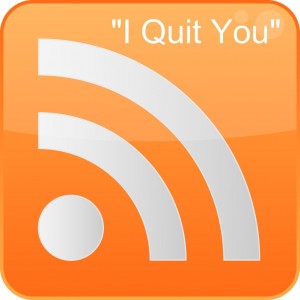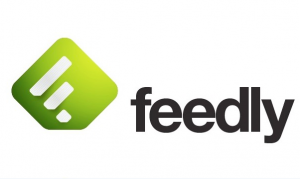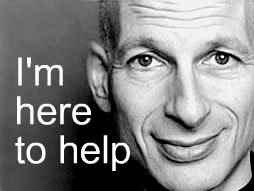“I Quit RSS”
Influential consumer web expert, blogger and growth hacking guru, Andrew Chen, set off a maelstrom of controversy when he recently announced his plan to “quit RSS” and require subscribing to his email list in order to receive updates.
Andrew’s succinct post reasons that Google’s plan to shut down Google Reader in July 2013 signals the waning viability of RSS for “infrequent, high quality” blogs, like his, in the face of high-frequency blogs and the rising popularity of publishing aggregators, like Flipboard or Techmeme. Additionally, RSS does not support interaction between writer and readers, such as Facebook and Twitter have become known for.
The litany of criticism that comes out in the comment stream is as interesting as the post itself, including one critique from one of his followers, author and marketing icon, Seth Godin. The general sentiment among objectors is that Andrew’s decision falsely implies that Google Reader is RSS rather than a useful application for which there are numerous viable alternatives. Perhaps more importantly, several comments say that shutting down RSS in favor of email means they simply will stop reading Andrew’s updates in favor of maintaining an unclogged inbox.
Andrew followed up with another post giving a more in depth explanation of his decision to quit RSS. He reinforces his original post and cites additional data and reasons for his position. He shows the decline in searches for RSS over the last several years, the trend toward “integrated” readers, and how email lists encourage better content through higher analytic capability, improved feedback loops, and the ability to iterate more precisely on the content that the audience values the most. Defiantly, he states that he is willing to lose readers if it means that those who stick with him are more engaged, and he reiterates: “RSS, I quit you.”
However, more criticism poured in, again led by Seth Godin, who points out that while email may be useful to some readers and allow greater benefits to Andrew, it costs nothing to keep RSS up and running for those who do not wish to subscribe. He implies that a reader’s decision not to subscribe is not so much because they are not interested or engaged in the content, but because of other reasons, like the ability to consume volumes of content “at a glance” or because they simply shouldn’t have to turn their email application into their content curation tool.
Andrew finally concedes in his response to Seth by accepting his comments and by stating that he will “keep RSS around but promote email as the primary way to stay in touch.”
First Rule of Blogging: Know Thy Audience
Andrew’s positions are on point from the position of the writer/publisher, but he misses the readers’ perspective, and also appears to forget the most important rule of blogging: Know thy audience. And just as importantly, know how your audience finds you and engages with you.
Andrew’s content is extremely valuable and worth subscribing to via RSS or email (I do both). However, as reflected in the backlash on Andrew’s posts and among my colleagues, the debate is less about the value of the content than the users’ need for tools other than email to control and curate the content they receive.
My Content Curation Process
RSS – Personally, I will not be signing up for 200 email lists to keep up with my current RSS subscriptions. Having put the panic attack of losing Google Reader behind me, I have evaluated other RSS options and found a suitable and nearly seamless transition over to Feedly. The user interface is  superior to Google Reader and it supports social sharing on desktop and mobile platforms.
superior to Google Reader and it supports social sharing on desktop and mobile platforms.
I believe RSS readers still have a life because they do much more than the other options.
- First RSS provides a quick way to view dozens of blog titles in one screen shot – a quick way to pick and choose and consume those of interest.
- Secondly, an RSS reader preserves the long shelf-life of great content where Twitter and aggregators are real time options. How would you find one of Andrew’s 500 essays on Twitter? With a weekly catch up schedule, I can get through literally 100’s of posts and stay current with my favorite writers.
Twitter has certain features that allow users to curate content feeds, such as user defined lists and the ability to follow certain hashtags with saved searches. For example, I have lists for “content marketers”, “SEO bloggers”, and “sales 2.0”, where viewing them only displays the posts for the “follows” I have added to the list. Many follow back and can then be a distribution channel for my content.
However, Twitter content, segmented or not, contains a lot of noise that can make it difficult to uncover valuable content out of the constant stream of conversation. Using Andrew as an example, he averages one new blog post per week, but he has a much higher volume of daily Twitter activity. While I value Andrew’s insights and observing some of his public interactions on Twitter can be interesting, most of it is not of value to me, and I do not want to scroll through each tweet to find his latest post or the other useful links he shares with his audience.
Aggregators, like Business Insider , Flipboard, and (increasingly) LinkedIn, provide broad, strategic content that covers current trends, news, and brings new writers and news sources to my attention. Andrew predicts that these aggregators will become increasingly attuned to user preferences, and therefore more precise in their ability to deliver optimal, personalized content. Still, I stand by my desire and ability to curate the content that I receive over any algorithm.
Like Twitter, aggregator content has a short shelf life given the volume of content pushed out on a daily basis, and unless I check every day, I might miss something valuable. Although aggregators are a source of new content to subscribe to, rarely do I see content from my existing subscriptions – including Andrew Chen’s.
Back to Andrew Chen
Now let’s go back to solving Andrew’s challenge – more audience interaction and analytics.
Given he’ll continue to support RSS subscriptions for the near-term, how can he get the data that an email subscription provides?
Let’s take his readers through a simple acquisition and conversion model built on his existing distribution channels with one modification – provide occasional differentiated content.
- Publish great content and attract new readers through all channels: social (Twitter, Linkedin, Google+), organic search and link building (blogs, guest posts, and publishers). Going great.
- Great content leads to subscriptions: Twitter follows, RSS, email (minority) and a committed audience. Twitter provides some customer insight: Retweets, location, follower bio, ability to direct message (DM). All without email address!
- NEW: create differentiated high value content as a consumption option monthly or quarterly: eBook, video interview, live chat session, etc. Andrew’s long form essays are perfect for this. High value content access is granted through a simple web form. One time data collection with auto-fill on future downloads. Fairly painless.
- Gradually form data is available for a larger percentage of subscribers.
- WIN/WIN. Andrew gets his data. RSS off life support (see Seth comment post two).
Stay tuned. For now, the skirmish is over, but the conversation lives on.



